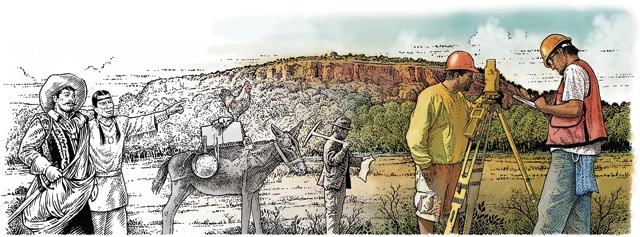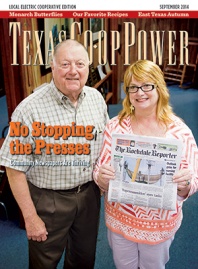The story of the Los Almagres Mine begins in 1753 during the Spanish Colonial era in Texas when Juan Galvan launched an expedition to locate a site for a mission. Apaches told him where the kinds of riches that white men crave could be found. The place was called Cerro del Almagres, or “The Ocher Mountain,” and later simply Los Almagres. Apaches helped the Spanish find the ocher mountain, but they found no riches.
The story might have ended there, but it did not.
Three years later, Bernardo de Miranda y Flores went to Los Almagres with a small expedition and reported finding “a tremendous stratum of ore.” To make sure people were paying attention, he promised “a mine to each of the inhabitants of Texas.” He sent a 3-pound sample to Mexico City to be assayed, but officials there said they needed 30 pack mule-loads of samples to make an accurate analysis. That never happened.
The mission site Galvan had been looking for turned out to be a spot on the San Saba River, near Menard. The mission didn’t fare well, but the presidio captain, Diego Ortiz Parilla, did send some miners to Los Almagres to work the mine. Parilla estimated that every 75 pounds of ore contained an ounce and a half of silver. Alas, Comanches destroyed the San Saba mission, Parilla was reassigned, and that would seem to be that.
But no. The story continued even into the era of Anglo settlement. Stephen F. Austin saw no harm in recounting the tales, especially for the benefit of fortune-hunting immigrants. He even included a lost silver mine on maps of the San Saba area.
Because of the connection to the San Saba mission, the story got twisted. The mission was on the San Saba River, but the mine was not. Thanks to Austin’s map, people started calling it the San Saba mine, and it attracted a new wave of fortune seekers like Jim Bowie and his brother Rezin. Over time, in step with new legends and rumors, Los Almagres also came to be called the Lost Bowie Mine.
In the early 1900s, historian Herbert E. Bolton used copies of Miranda’s journal to locate the mine, placing it in the Riley Mountains in Llano County, on the north side of Honey Creek. He was so sure of his find that he and a partner started a mining company there—but results were something short of spectacular. The mine closed two years later.
A University of Texas history student, Roderick Patton, became interested in the mine half a century later and conducted his own exhaustive review of the historical records. His conclusion: Bolton got it right.
Around that same time, Llano County rancher James Stotts discovered a group of mines on his land, just on the other side of Honey Creek from the Bolton site at Packsaddle Mountain. He invited a friend and amateur historian named Joe Wallace to help him investigate it. They became convinced Stotts had discovered the real Los Almagres. The Texas Historical Foundation got interested and in 1998 contacted geologist S. Christopher Curran to visit the mines and offer his findings.
Curran assembled a team of historians and archaeologists that found ample evidence of three mining vintages on the Stotts Ranch, including Spanish Colonial. Curran concluded that Stotts and Wallace got it right; the fabled mine is located at Packsaddle Mountain.
“Whether the Stotts mines are, in fact, the actual mines described by Miranda may never be known with certainty, but they appear to be the right age and more closely match Miranda’s description than do any other mines,” Curran wrote in 2000. “There is substantial evidence to support a preliminary conclusion that the oldest mines at the Stotts Ranch are the Los Almagres mines.”
Though that would seem to put an end to the story, it probably won’t. Miners, as far as we know, never had great success at Los Almagres, but storytellers found the mother lode.
————————-
Clay Coppedge, a member of Bartlett EC, lives near Walburg.


